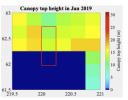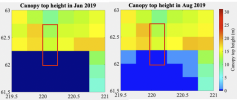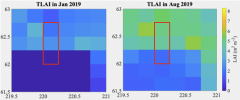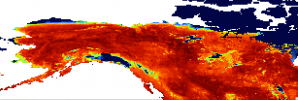The figures above show the grid-average LAI.
I checked the forcing data, and they are well interpolated from a 1degree by 1degree to the 0.25 degree by 0.25 degree.
I investigated one grid in the 'box' and the two adjacent upper grids that are just outside the 'box', shown in the red rectangular in the following figure.

Here is the pfts in the three grids (from up to low corresponding to the upper, middle and lower grids)

1. Bare ground
9. Broadleaf Deciduous Boreal Tree (BDBT)
3. Needleleaf Evergreen Boreal Tree (NEBT)
12. Broadleaf Deciduous Boreal Shrub (BDBS)
13. C3 Arctic Grass (C3AG). And the dominant pft of the two grids is needleleaf evergreen boreal tree (NEBT).
The tree girds have the same first dominant pft NEBT and the second pft C3AG.


The grid percentage of the NEBT (the first column) and C3AG(the second column) in the three grids are pretty similar.
I did a two-year (2018-2019) model time experiment and output variables including the canopy top height and LAI at the pft level into the history files.
And I plot the time series of monthly canopy top height and LAI of the four pfts: 3, 12, 9 and 13 in the three grids during the period.

And you can see that the tree or shrub in the upper and middle grids has right size and reasonable phenology. But the tree or shrub in the lower grid has almost zero (0.01 m for NEBT and 0.096 ~ 0.98 m for BDBS) canopy height and zero LAI all year around. The increase of canopy top height or LAI in summer in the lower grid is contributed by the growth of c3 arctic grass.


And I checked the canopy top height of pfts at the pft level in the three grids from the interpolated file finidat (it is interpolated from a 1 degree present-day initial file). Here is the pfts and the corresponding canopy top height.


NEBT (3) and BDBS (12) in the top two grids have the similar height, while in the lower grid their heights are 0.01 m. LAI for NEBT is above 3 in the two upper grids and 0 in the lower grid. So it seems the 'box' is inherited since the initialization. And we are so confused why the two adjacent grids have the so different display of the same pft (say NEBT), and the so rectangular the 'box' is.
The two-year experiment case
/glade/work/huoxl/cases/ctsm/PPE.n01_ctsm5.1.dev012_0.25x0.25_arctic_cam6for_checkblock
/glade/scratch/huoxl/ctsm/PPE.n01_ctsm5.1.dev012_0.25x0.25_arctic_cam6for_checkblock/run
The spin up experiment case where you can find the finidat.nc
/glade/work/huoxl/cases/ctsm/PPE.n01_ctsm5.1.dev012_0.25x0.25_arctic_cam6for_spinup
/glade/scratch/huoxl/ctsm/PPE.n01_ctsm5.1.dev012_0.25x0.25_arctic_cam6for_spinup/run
The two-year experiment has the same configuration except for the pft level output, and it is specifically used for diagnosis analysis of the 'box'. If you want to see the finidat.nc, you can go the spin up experiment and it is interpolated from the 1 deg file /glade/scratch/huoxl/2011-01-03-00000/f.e21.FHIST_BGC.f09_025.CAM6assim.011.clm2_0001.r.2011-01-03-00000.nc
Sincerely,
Xueli







